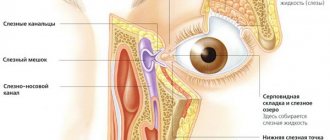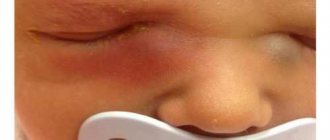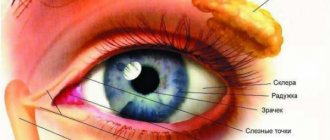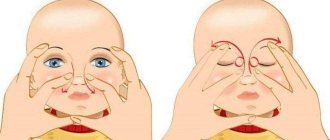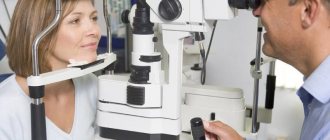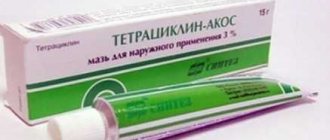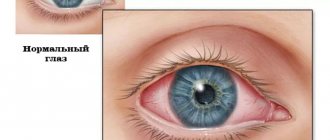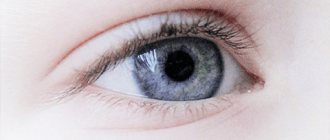Bacterial conjunctivitis of the eyes in a child
The cause of this type of disease is the contact of various pathogens on the mucous membrane of the organs of vision: gonococci, staphylococci, streptococci and other pathogenic microorganisms. This can happen when the baby bathes in insufficiently clean water or when rubbing the eyes
In this article
- Bacterial conjunctivitis of the eyes in a child
- Dacryocystitis of the eye in newborns
- Requirements for eye massage in newborns
- How to do eye massage for newborns correctly
- What to do if massage does not help with conjunctivitis and dacryocystitis
- Hygiene during treatment of dacryocystitis and conjunctivitis in children
with dirty hands, and there are also frequent cases of infection of the child at the time of birth if pathogens are present in the mother’s genitourinary area. In medical practice, there is a special term - ophthalmia of newborns. This is the name for inflammatory diseases of the visual organs after birth. At the same time, one should not confuse the regular accumulation of exudate in the inner corner of the baby’s eye, as often happens in the morning, with conjunctivitis of the eyes, the signs of which are quite pronounced: copious discharge of pus, increased lacrimation, itching, sticking of eyelashes in the morning, restless behavior of the child. Often, pathology develops in both eyes at once.
Symptoms of dacryocystitis
1. Watery eyes.
2. Purulent crusts from the eye (especially after sleep).
3. Swelling and redness of the skin near the lacrimal sac (when pressure is applied to it, mucous or purulent fluid is released from the lacrimal openings).
4. When the inflammatory process spreads beyond the lacrimal sac, in the absence of treatment, phlegmon can develop - a serious disease, especially for a newborn. Symptoms of phlegmon of the lacrimal sac:
- sharp swelling in the area of the lacrimal sac at the inner edge of the eyelids,
- heat,
- leukocytosis, increased ESR (according to CBC)
5. With a prolonged course of dacryocystitis and lack of treatment, keratitis may develop. Keratitis is an inflammation of the cornea followed by the formation of ulcers on its surface.
The danger of dacryocystitis also lies in the fact that a permanent reservoir of pus, which in such cases is the lacrimal sac, represents a chronic threat to the cornea of the eye, in which, with dacryocystitis, purulent corneal ulcers can occur.
Treatment of dacryocystitis should begin immediately after diagnosis. Treatment of dacryocystitis in newborns can be:
- conservative (massage of the tear duct, eye antiseptic)
- surgical (probing with lavage of the nasolacrimal canal)
Dacryocystitis of the eye in newborns
Another common eye pathology in infancy is dacryocystitis. This is an obstruction of the lacrimal canal, which causes stagnation of tears in it. There are two such tubules in total - on the side of the upper eyelid and the lower. 90% of the tear fluid flows through the lower canal into the nose, further moisturizing it from the inside. This is why when we cry and excessive lacrimation occurs, a runny nose occurs. Before a baby is born, its tear ducts have a thin membrane of fetal tissue. It protects the visual organs from amniotic fluid entering them. Usually this film breaks after birth, when the baby takes his first breath and his eyes begin to work normally. However, it happens that the film does not want to break, and then the normal outflow of tears is disrupted, infection occurs and dacryocystitis occurs - purulent inflammation of the lacrimal sac. Here are the main manifestations of this disease in a newborn:
- purulent discharge from the baby’s eyes in the second week of life;
- redness of the conjunctiva and skin at the inner corner of the eye;
- painful swelling, swelling of the eyelids;
- lacrimation;
- discharge of pus when pressing on the area of the lacrimal sac;
- eyelashes stuck together after sleep;
- temporary effect from the use of antibiotics and antiseptics.
Externally, the manifestations of the disease resemble eye conjunctivitis, and parents often practice independent treatment: washing the eyes with chamomile or tea infusion, instilling antibacterial drops. The symptoms disappear for a while and then recur. Since the main cause is not eliminated, the tear continues to stagnate, new bacteria enter the palpebral fissure and begin to multiply.
Every time a child develops purulent discharge from the eyes, there is no need to look for advice on the Internet; it is worth visiting an ophthalmologist for diagnosis. Only a specialist will determine what pathology caused the inflammation: conjunctivitis, dacryocystitis or something else. Standard treatment regimens for inflammatory eye diseases include rinsing the vision organs, administering drops and ointments. The doctor may also additionally prescribe an eye massage for clogged tear ducts to more effectively remove excess pus. It can be carried out by parents independently at home. Massage is an important procedure at the initial stage of treatment of eye conjunctivitis and dacryocystitis, as it affects the cause and is aimed at improving the patency of the lacrimal ducts.
General information
The proper functioning of the visual system is influenced by many factors, one of which is tears. They are necessary to protect the eyes from dust and debris, and to keep the membrane of the eye moist. The lacrimal apparatus consists of glands that produce tears; excess tears are excreted through the lacrimal ducts into the lacrimal sac, and then into the nasal cavity.
If the ducts stop working normally, bacteria accumulate in the sac, it becomes blocked, and as a result, inflammation of both the lacrimal sac and the mucous membrane of the duct begins, and it becomes impassable. This inflammation is a very dangerous pathology - dacryocystitis.
This disease most often occurs in infants and young children, but sometimes it can occur in adults, especially women, as a complication after injuries, damage to the nasopharynx or previous colds. The main clinical feature of dacryocystitis is severe purulent discharge from the lacrimal sac, which is especially evident after sleep or during crying.
Requirements for eye massage in newborns
Massaging with conjunctivitis or dacryocystitis requires compliance with certain rules so as not to harm the newborn. Be sure to cut long nails - they can injure the child's delicate skin or eyes. Wash and dry your hands thoroughly to avoid introducing another infection. You need to massage when the baby is in a calm, relaxed state, preferably five minutes after feeding. Do not carry out this procedure if the baby feels unwell or has a fever. Before you start massaging your eyes, rinse them and clean them of any traces of purulent discharge.
Take an antiseptic liquid - it can be a weak solution of furatsilin, a decoction of chamomile, or a weak infusion of tea. A cotton swab is moistened in the liquid and the pus is carefully removed, making movements from the outer edge of the eye to the inner, that is, from the temple to the nose. Use a separate cotton pad for each eye.
Harm of lacrimal duct massage in newborns and contraindications
One of the diseases that causes disruption of the functioning of the lacrimal ducts is dacryocystitis. The problem can be solved with massage. But not all children can do this harmless procedure.
Massage of the lacrimal canal in newborns has the following contraindications:
- dropsy of the lacrimal sac. It occurs on the back of the nose. The tumor is painful and greatly thins the skin;
- presence of phlegmanoma. This disease, in the absence of a well-developed treatment package with medications, can cause necrosis of the tissue around the lacrimal sac. In the most difficult cases, massage should be performed in a clinic. There, specialists will carefully examine the baby and perform all necessary actions;
- respiratory diseases;
- elevated temperature. In this case, the procedure should be postponed until the child recovers.
It should be understood that massage movements done incorrectly can worsen the child’s condition and cause unpleasant complications. Incorrectly performed movements when massaging the eyes contribute to the penetration of pus into the tissues and the development of infection in the brain.
It is important to observe hygiene rules and carefully select materials for work. For example, cleaning from pus should be done with a treated disinfectant, sponge or napkin. You cannot use cotton wool or a bandage for these purposes: their fibers can get into the eye, and the inflammation will become even worse.
In the absence of suppuration, experts advise applying a warm compress to the eye area before the massage. This will increase the effectiveness of the procedure itself. Before starting a session, parents should study the anatomical structure of the eye in order to more accurately find the points that need to be affected.
Despite its effectiveness, massage of the tear duct is not the only way to solve the problem. Other treatment options are also possible. The love and care of parents and the professionalism of doctors will help restore the health of a newborn. You should not put your child’s health at risk: if you are not sure of the correct execution, it is better to trust a specialist.
Article design: Vladimir the Great
How to do eye massage for newborns correctly
The doctor will show you how to properly massage the lacrimal sac so that the process brings maximum benefit. You can also feel this pouch in yourself to better understand where it is. Place your index finger on the point in the inner corner of the eye where two canaliculi meet before entering the lacrimal sac. The pressure should not be too strong, but at the same time sufficient to expel the pus. From the found point, move from top to bottom towards the child’s nose, lightly pressing your finger. It is necessary to make approximately 6-10 such movements. In this case, pus should be released from the lacrimal sac - this is an indicator that the eye massage is carried out correctly. It is removed with a cotton swab and this continues until the contents of the canal stop coming out.
After completing the procedure, you need to rinse the eye with antiseptic solutions and then instill an antibiotic. This could be a solution of Levomycetin 0.25%, Vitabact or other means. Experts recommend performing eye massage for conjunctivitis in children or obstruction of the lacrimal duct for two weeks, while using antibacterial drops or ointments. Usually during this time the process normalizes and the tear begins to flow normally.
As a rule, the doctor’s prescription looks like this:
- eye massage - 4 times a day for 6-10 movements;
- washing with an antiseptic solution;
- "Levomycetin" 0.25% 1 drop * 4-5 times a day.
Step-by-step massage technique
After cleansing the newborn's eye, drops prescribed by the ophthalmologist should be placed into the conjunctival sac and proceed to the massage procedure.
The procedure should not last more than 1 minute, each movement is accompanied by pressure for 2-3 seconds:
- Massage is performed only on the side on which there is obstruction.
- Use the pad of your index finger to find the lacrimal sac, in the area above the inner corner of the eye, closer to the eyebrow.
- With quick, light, pressing movements towards the wing of the nose, as if drawing commas, make 5-10 intermittent movements and one smooth one from the wing to the inside of the eye and repeat again.
- After which you need to drip antibacterial or other drops into both eyes of the newborn into the conjunctival sac.
Massage before feeding, otherwise the newborn may vomit.
What to do if massage does not help with conjunctivitis and dacryocystitis
It happens that the prescribed treatment does not help, and conjunctivitis of the child’s eyes occurs again and again. The doctor prescribes various antibiotics, but after a short-term improvement the eye becomes inflamed again. In this case, an operation is prescribed - probing. It is performed under local anesthesia. The doctor inserts a probe into the nasolacrimal canal, breaking through the embryonic film, and then rinses it. It is necessary to restore the patency of the canal by the age of six months, otherwise phlegmon may develop in the future. In addition, the thin membrane begins to thicken over time, and it becomes more difficult to break through.
After the operation, a course of eye massage and special drops are prescribed to prevent the formation of adhesions, which can lead to relapse of the disease, again blocking the tear duct. If probing does not have the expected effect, an additional extended diagnosis of the child’s visual organs is carried out: perhaps the reason lies in an anomaly in the development of the nasolacrimal canal, a curvature of the nasal septum or other factors. In some cases, a child may need dacryocystorhinostomy - a complex operation that is performed only when he reaches the age of 5-6 years.
Types of lacrimal canal massage in newborns and techniques of implementation
After cleansing the eyes, you can proceed to the massage itself. To do this, experts recommend using your finger to find the tubercle located at the junction of the eye and the bridge of the nose. Moving the finger a little higher, downward movements are performed. 10 manipulations of the nasolacrimal duct are enough.
Movements are performed without interruption. The lacrimal sac itself can be pressed gently, with light vibrating movements without pressure. The direction of movement is only from top to bottom and only the latter can be done in the opposite direction. If during a massage pus accumulated in the canal appears, then you need to interrupt the massage and remove the mucus with a sponge with an antiseptic. After this, the procedure can be continued.
After the massage, special drops are instilled into the eyes, and even if the problem is with one eye, the medicine is instilled in the second one. Otherwise, the infection will spread to him.
Massaging the lacrimal canal in newborns using this technique is simple to perform; the main thing is to study the rules of implementation and act carefully, since the child’s bones are not yet very strong and strong pressure can lead to injury to the eyeball. It is most convenient to relieve the baby of the membrane plug when he cries. At the same time, the pressure inside the eyes increases and the substance is released under pressure.
It is recommended to carry out the procedure before feeding, using your index fingers. All movements are directed and jerky. Massage should be carried out primarily on the problematic side, but for prevention, the other eye is also treated.
Precautionary measures include preliminary consultation with specialists to confirm the diagnosis. Before you do a massage yourself, you need to see how professionals do it. Careful adherence to hygiene rules is required and it is imperative to disinfect hands and skin surfaces after each session.
It is important to consider: the bone tissue in such children is easily damaged, so you should not put too much pressure on the eye.
This treatment can be carried out for up to 3-4.5 months. In the future, it is necessary to take more stringent measures, because the likelihood of complications is high. This is probing and the use of antibacterial drugs.
If treatment is not started promptly, the elasticity of the lacrimal sac and the canal itself decreases, leading to dysfunction, and in some cases even the formation of fistulas and visual impairment.
Hygiene during treatment of dacryocystitis and conjunctivitis in children
Try not to visit too crowded places with your child - it is better to conduct the course of therapy exclusively at home. It is advisable to change the diapers in your baby's crib every day. When administering drops, make sure that the tip of the bottle dispenser does not touch the mucous membrane and skin around the eyes, otherwise this may cause re-infection. Instill exactly as much medicine as prescribed by your doctor. After completing the procedure, you need to carefully blot the area around with a clean napkin and wash your hands again.
In advanced cases, eye conjunctivitis, especially bacterial, can lead to severe damage to the eye structures and loss of vision. If treatment of dacryocystitis is delayed, phlegmon of the lacrimal sac may occur. This disease is accompanied by high fever, the child becomes restless and cries. The result of the disease can be the formation of fistulas in the lacrimal canal. Carefully following all the doctor’s recommendations, as well as observing the rules of hygiene, will help eliminate the symptoms of inflammation as soon as possible.
The effectiveness of massage
If dacryocystitis is not treated, it can lead to purulent tissue inflammation. Statistically, women suffer from dacryocystitis more often because their tear duct is narrower.
Massage performed using the correct technique is the main conservative treatment for the disease. It is most effective at the initial stage of pathology development. One of the main advantages of the procedure is that it can be performed at home.
It also allows you to cope with the problem without surgery and long-term use of antibiotics. Dacryocystitis is dangerous because it can provoke the spread of infection throughout the body and its penetration into the brain.
The manual technique allows you to completely remove purulent discharge and prevent its further accumulation.
Treatment
The most important method of getting rid of the disease is conservative treatment. The effect on the projection area of the tubule is its most effective component. Antiseptic solutions are used to treat the passage. If conservative therapy does not help before 8 months of age, surgical intervention is prescribed. Massage is a real way to avoid surgery and restore the patency of the canal in 99% of cases.
You should consult a doctor in the following cases:
- constant lacrimation (this indicates that the child’s tear duct has not opened);
- discharge of large amounts of mucus and pus from the eyes;
- inflammation of the conjunctival membrane;
- cloudiness of tears due to mucus in them.
Advice from Dr. Komarovsky
Dr. Komarovsky advises parents not to self-medicate. Only a doctor prescribes ointments or drops with antibiotics for sore eyes. Moreover, before selecting a medicine, a bacterial culture is carried out, the task of which is to find out which pathogen led to the development of the disease. The frequency of drug administration is also determined by the attending physician.
Drops after massage, according to Komarovsky, do not need to be instilled after each massage procedure. After all, there are 7 or even 8 of them per day. Such frequent application of drops or ointment is impractical.
It happens that parents do not fully understand the technique of the procedure. In this case, there is no need to try to carry out the procedure at any cost. It is better for a young mother to go to a children's clinic, where they will show her how best to massage the lacrimal canal.
Dr. Komarovsky advises not to use a medical bandage to rinse the tear duct. Small villi contained in these materials can get into the membranes of the organ of vision and worsen its condition.
When there is no pronounced purulent process, a warm compress is applied before the massage. The effect of this will be much better.

